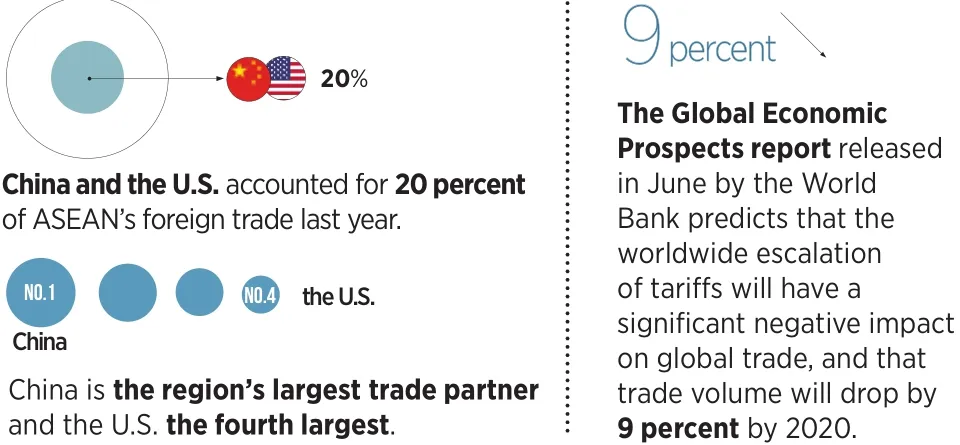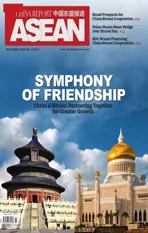HOW DOES CHINA-U.S.TRADE FRICTION AFFECT CHINA-ASEAN ECONOMIC RELATIONS
2018-11-19ByXuNingning
By Xu Ningning
The Facts and China’s Position on China-U.S. Trade Friction, a white paper recently released by China’s State Council, states in its opening, “China is the world’s biggest developing country and the United States is the biggest developed country. Trade and economic relations between China and the U.S. are of great significance for the two countries as well as for the stability and development of the world economy.”
Combined, China and the U.S. accounted for 20 percent of ASEAN’s foreign trade last year, with China as the region’s largest trade partner and the U.S. the fourth largest. The ongoing trade war between the world’s two largest economies will have considerable impact on the trade and economic ties between China and ASEAN countries.
Boosting Chinese Investment in ASEAN
The tension between China and the U.S. will motivate more Chinese businesses to set up factories in ASEAN countries and ship products from there to the U.S. to circumvent the U.S. market barrier. Due to the absence or deficiency of relevant industries in the host country,these factories are expected to import equipment and materials from China, which will boost trade between China and ASEAN. Meanwhile, the volume of ASEAN countries’ foreign trade, especially with the U.S., will increase, likely leading to a widening surplus with the U.S.
There are good reasons for Chinese and ASEAN companies to form closer partnerships. The two sides are friendly neighbors that sustain close trade and economic ties. China has been ASEAN’s largest trade partner for nine years in a row, and ASEAN has been China’s third largest trade partner for seven consecutive years. For the pastfive years, ASEAN has remained the top destination for overseas investment from Chinese companies as well as China’sfifth largest trade partner for both exports and imports of services. With the establishment of the China-ASEAN Free Trade Area, the two sides open their markets to each other with accompanying cooperation policies and cooperate to boost economic growth. In past years, the number of Chinese businesses entering ASEAN countries has been increasing. Even more are predicted to make the move as China-U.S. trade relations sour.
Impact on ASEAN Economic Growth
The Chinese and ASEAN economies are highly interdependent. Consequently, if China’s economic growth slows amid trade con flicts with the U.S., the economic growth in ASEAN countries will also be affected. A strong Chinese economy demands more imports from ASEAN, especially commodities. Likewise,in a booming economy, ASEAN will buy more from China including machinery, building materials and daily commodities. Chinese products have a clear price advantage in the ASEAN market.
Following the signing of currency swap agreements between China and ASEAN countries, the RMB is now used more in bilateral trade. Its stability is tied to the currencies of these countries, and the stock markets in China and ASEAN also in fluence each other. The trade war launched by the U.S. will not only harm the Chinese economy but also the economy of ASEAN countries and the world at large.
The Global Economic Prospects report released in June by the World Bank predicts that the worldwide escalation of tariffs will have a significant negative impact on global trade, and that trade volume will drop by 9 percent by 2020. This impact is particularly acute on emerging markets and developing economies, especially those deeply engaged with the U.S. trade orfinancial markets.
Impact on Industrial Chains
The trade war will trigger changes to the industrial chain linking China and the U.S., which will exert a ripple effect on ASEAN, affecting products ranging from electronics to apparel. For instance, parts produced in Singapore and Malaysia are assembled into products in China for sale in the U.S. This industrial chain is now interrupted by soaring tariffs imposed by the U.S. on Chinese exports. The result is lower productive efficiency and higher costs and retail prices.

A general view at the Yangshan Deep-Water Port, an automated cargo wharf in Shanghai, on April 9, 2018.
The World Economic Outlook report released by the IMF in April points out that an increase in tariff and nontariff trade barriers could disrupt global supply chains and slow the spread of new technologies, reducing global productivity and investment. American think tank the Peterson Institute for International Economics predicts that if the U.S. continues to slap punitive tariffs on China that prompt countermeasures, many countries and regions exporting raw materials and intermediate products to China will take a big hit.
Impact on Industrial Upgrade
A key reason the U.S. is waging the trade war with China is to contain its development of hi-tech products and torpedo its Made in China 2025 plan. This plan is poised to benefit not only China but also many other countries, including ASEAN members in China’s neighborhood which are undergoing rapid economic growth. Chinese products, technologies and services are traded at lower prices than those from the U.S. The ongoing trade con flict will stunt corporate investment and impede the spread of new technologies, which will in turn slow industrial upgrades and economic growth in ASEAN countries. Chinese companies should make preparations for a protracted trade battle between China and the U.S.

The Facts and China’s Position on China-US Trade Friction declares: “Since taking office in 2017, the new administration of the U.S. government has trumpeted‘America First.’ It has abandoned the fundamental norms of mutual respect and equal consultation that should guide international relations. Rather, it has brazenly preached unilateralism, protectionism and economic hegemony, making false accusations against many countries and regions, particularly China, intimidating other countries through economic measures such as imposing tariffs and attempting to impose its own interests on China through extreme pressure.”
The current tariff imposition is actually part of strategic containment of China by the U.S. More than a tactic of the Trump administration to ensure Republicans win in the mid-term elections and Trump’s own reelection in 2020—it will not calm after the mid-terms. Waging the trade war marks a shift in the U.S.’s China strategy and serves the fundamental purpose of containing a rising China and stopping it from growing into a world power.
In this context, enhancing China-ASEAN cooperation has become the pragmatic option to boost regional economic growth and a common need of both parties to consolidate their strategic partnership. Even without discord over China-U.S. trade, China and ASEAN would still need to step up trade and economic cooperation,which is in the best interests of both parties.
